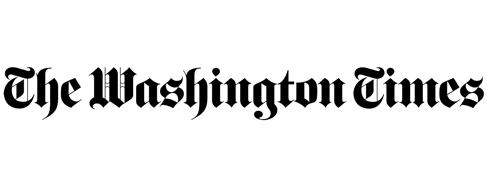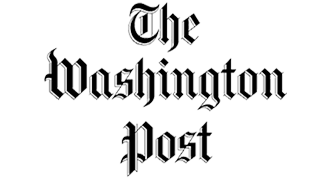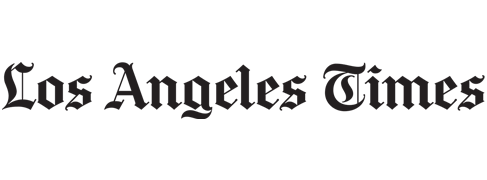Chin Augmentation/ Chin Implant in Washington DC
Chin Implant and Osseous Genioplasty
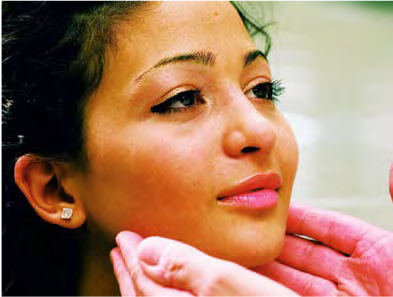

Introduction to Chin Augmentation/ Chin Implant
Chin surgery (often called mentoplasty or genioplasty), is a surgical procedure that has the ability to increase chin projection and improve the facial shape, soft tissue laxity, and facial asymmetry. Simply augmenting anterior chin projection can be accomplished by either placing a chin implant or by moving the chin bone forward. However, the unidimensional augmentation of an implant is a somewhat simplistic approach to chin surgery and misses a powerful opportunity to improve facial form. Dr. Baker has found that the ideal chin position plays an important role in support of the perioral soft tissue, submental tissue laxity, facial shape, and facial proportion. It is important to understand the results chin surgery is capable of achieving to help you make an informed decision regarding your surgical options. In the majority of cases, actually moving the chin to a new position is advantageous for reasons that Dr. Baker will discuss at the consultation and are described below.
Dr. Baker, a plastic surgeon who performs chin surgery in Washington, D.C., and McLean, VA, will help you choose the approach that best suits your goals. The general goal of cosmetic chin surgery is to provide a harmonious balance to your chin and facial features so that you feel better about the way you look.
Dr. Baker’s Expertise in Chin Surgery
Professor of Plastic Surgery in the Medstar Georgetown University, Department of Plastic Surgery, and the Georgetown University School of Medicine with over 20 years of experience.
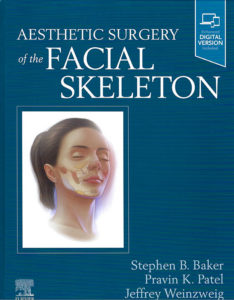 Authored the textbook on Aesthetic Surgery of the Facial Skeleton.
Authored the textbook on Aesthetic Surgery of the Facial Skeleton.
Authored multiple chapters and peer-reviewed manuscripts on chin surgery.
Instructor for national courses on chin surgery.
Invited moderator and panelist on chin surgery at national meetings.
American Society of Maxillofacial Surgeons Visiting Professor on chin surgery, rhinoplasty, and jaw surgery.
Training in plastic surgery, maxillofacial surgery, and craniofacial surgery provide him the tools to perform a complete assessment of each patient’s facial structure. He is trained in all modalities of addressing your problems, so he is not limited in the solutions he can provide to address your concerns.

This infographic prepared by the Aesthetic Surgery Journal highlights Dr. Baker’s publication describing the role of the osseous genioplasty in lower face and neck rejuvenation. Click link to read Dr. Baker’s publication
Undergoing a surgical procedure is a serious undertaking for a patient and it is Dr. Baker’s goal to help you make the best decision for your personal goals. It is hoped that the following information will aid in your decision as to whether a chin procedure will meet your expectations and if so, which is the best procedure for you.
What can chin surgery accomplish?
The majority of patients who inquire about chin surgery are seeking to add projection to their chin. Having a recessed chin can compromise the facial profile because of inadequate projection, laxity of the tissue in the chin and neck, and less linear distance from the neck to the chin which compromises aesthetics. Chin surgery can augment chin projection, enhance facial shape, decrease aging soft tissue laxity, correct asymmetry and correct an unfavorable labiomental crease (the angle between the lower lip and the chin).
Will a genioplasty make me look younger or delay signs of facial aging?
Many patients feel that they need a neck lift, but after an assessment, realize that they would actually benefit much more from a genioplasty and are surprised to see how a genioplasty can tighten and improve the soft tissue laxity around their mouth and under their chin. Unlike a chin implant, a genioplasty allows three-dimensional positioning of the chin to maximize soft tissue support. By combining anterior and inferior movements in appropriate patients, a powerful lifting effect is achieved. Additionally, several muscles that contribute to laxity and fullness under the chin connect to the back of the chin bone: anterior digastric, geniohyoid, and anterior mylohyoid. When the chin is advanced, these muscles are tightened giving a more defined appearance to the patient’s jawline and reducing fullness under the chin. Because a chin implant just “sits” anterior to the chin, it is not capable of producing these beneficial effects.

Because an osseous genioplasty actually stretches the muscles under the jaw as the chin is advanced, it is a much more powerful rejuvenative procedure for the neck and lower face than a chin implant. The patient on the right presented for a neck lift, but after consultation underwent an osseous genioplasty. The soft tissue laxity shows improvement and the new skeletal support of the soft tissue is a permanent improvement that will last the patient’s lifetime.
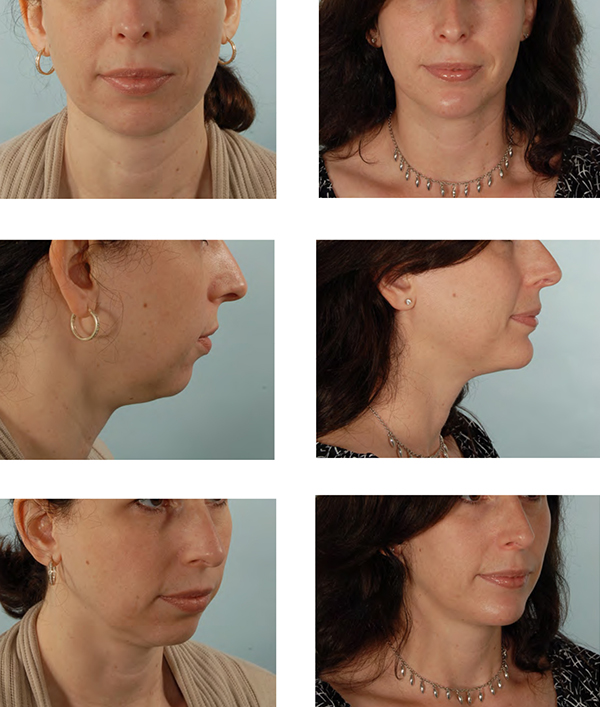
Will chin surgery make my nose look smaller?
Augmentation of the chin will soften the appearance of a larger nose. Projection of the nose and chin are intimately related and frequently patients who complain of large noses will benefit from advancing chin projection. If necessary or requested, both a chin and nose procedure can be done at the same time. The patient below on the left has a slight dorsal hump on her nose but the perception of a large nose is exacerbated by her insufficient chin projection.
Can chin surgery change my facial shape?
The chin can also be lengthened, narrowed, widened, tapered, or shortened to change facial shape from square to oval or shortened to bring a long face into balance. Frequently men desire to masculinize their face or women desire to feminize their face through surgery of the chin. The patient on the right desired chin advancement but also lengthening to give a more tapered feminine shape to her face.
How are the surgeries performed?
Chin implant: A chin implant is an implant made from medical grade “plastic” or silicone. The ideal indication for a chin implant is a patient who has deficient anterior chin projection with a pre-existing obtuse labiomental crease. A small incision is made under the chin and the implant is placed and secured with titanium screws to maintain the implant in its desired position. The incision is then closed and sutures are removed in the office in 7-10 days. Afterwards, there is minimal bruising and swelling with the patient returning to normal activities of daily living immediately.


How are the surgeries performed (cont.)?
Genioplasty: The chin is just a “button” of bone on the lower jaw. When it is moved, the lower jaw remains intact so there are no diet limitations, no rubber bands, or difficulty with speech afterwards. An invisible incision is made inside the mouth that allows Dr. Baker to mobilize the chin and move it to its new position. A small titanium plate is used to hold the chin in its new position and then the incision is closed with dissolvable sutures. The advantage of this technique is that it allows new chin positioning with control of the labiomental crease and allows for three-dimensional movement. In a genioplasty, the bone is being moved forward, and the muscles and tissue of the neck that attach to the back of the chin are being pulled tighter. This tightening of the soft tissue under the chin has a rejuvenating effect on the soft tissues of the neck resulting in a more youthful appearance. The recovery is relatively rapid with most patients returning to normal activities within days of surgery.

Filler chin augmentation
Filler has been used to change chin shape or increase chin projection. Filler is a reasonable option for minor improvements that is done in the office with immediate results. The more of a correction necessary, the more compromised a filler result becomes as a higher percentage of the chin volume is filler rather than soft tissue overlying bone (the normal chin anatomy). One of the core principles of Plastic Surgery is to “replace like with like.” The chin is made from both bone and soft tissue and trying to augment or create a chin beyond a mild degree with filler will result in an ill-defined, mobile mass of tissue that appears abnormal. Because filler is temporary, it needs to be redone every 6-8 months depending on the filler used. Permanent fillers are not recommended by Dr. Baker. Because a permanent filler is by definition permanent, where and how much one places today is static and will not age well as the patient’s soft tissues change over time. As you mature, your soft tissue will change but a permanent artificial soft tissue filler will not. Unlike the permanence of a chin implant or genioplasty which can be easily modified, soft tissue fillers are incorporated into the soft tissue making removal very difficult without adjacent tissue damage and potentially visible deformities after removal.
What is the difference between a chin implant and a genioplasty?
Surgeons who are equally comfortable at both chin implant and genioplasty surgery have long recognized that an osseous genioplasty achieves a superior aesthetic result in the vast majority of patients. It provides a three-dimensional solution that can improve chin projection, improve soft tissue sagging under the jaw, taper facial shape, and optimize vertical position. A chin implant is only capable of improving anterior projection, and an important part of an aesthetic chin is an aesthetic labiomental crease (the angle that is made from the lower lip to the chin). If this angle is normal or acute before the chin implant, the crease will be too acute giving a less pleasing, unnatural result. This is commonly seen in post chin implant patients but can be avoided with a genioplasty.
Why did most of my friends get a chin implant?
Most plastic surgeons are either uncomfortable or cannot perform a genioplasty, so an implant is the only option they offer their patients.
What is the difference in recovery between a chin implant and a genioplasty?
Because a large portion of Dr. Baker’s practice is on skeletal facial surgery, he is very comfortable and efficient in genioplasty surgery. In his experience, the recovery for a genioplasty is no different than a chin implant. The swelling is similar, there is rarely bruising with either procedure, possible temporary lower lip numbness for either, and a return to normal activities of daily living for most patients within 1-3 days.
Why do I need titanium screws for my implant or genioplasty?
Titanium screws are necessary to secure the implant to the chin so that it does not “float” off the bone compromising the accuracy of the desired projection as well as prevent implant migration requiring revision surgery. In a genioplasty, titanium is used to hold the chin segment in its desired position while the bone heals. Titanium is the same material used in dental implants and does not set off airport alarms or prevent you from having a future MRI.
Why do I have a small chin?
A high percentage of patients in the Washington DC – Tysons Corner area have had orthodontics or has their children in orthodontic therapy. Orthodontic therapy corrects a malocclusion and the most common malocclusion is an overbite. This means the lower jaw is recessed and the upper teeth are ahead of the lower teeth. To correct the bite the upper teeth are retracted to meet the lower teeth. As upper teeth are tipped back to meet the lower teeth, the upper lip follows the upper teeth and moves posteriorly giving the nose a prominent look. An option to avoid this is to surgically advance the lower jaw, but many patients are either not aware of this option or do not wish to undergo this procedure. As a consequence, after orthodontic therapy, the occlusion may look great, but the facial proportions are often compromised giving the patient the appearance of a large nose and a small chin.
Orthognathic camouflage
Some patients who had their overbite corrected orthodontically (see above) to achieve a good occlusion will complain that their nose looks too big and they have no chin. As these patients age, they may see laxity in their necks at an earlier age than their peers who have a more balanced jaw relationship. This type of facial imbalance can be corrected by performing nose and chin surgery to reduce the nose and augment the chin to restore facial balance. It is beneficial to have a person do this evaluation who is competent in jaw surgery as well because in certain cases, jaw surgery is an option that should be discussed with the patient.
What to expect in your Chin Augmentation Evaluation
At your consultation for chin surgery, Dr. Baker will perform a comprehensive evaluation of your face, chin, occlusion, and soft tissue envelope. The factors that are incorporated into your treatment plan include chin projection, proportion, soft tissue tissue laxity, symmetry and facial shape. The chin and anterior jaw play an important role in supporting the soft tissue under the chin and jaw as well as the marionette lines and jowls.
During the evaluation, Dr. Baker will evaluate the soft tissue support and how to optimize the rejuvenation effect of your chin surgery. Also, he will evaluate your occlusion and lower jaw to see how their position may contribute to your concerns and affect or limit your result. In some patients, a retruded lower jaw may be playing more of a role in your concerns than just the chin. Dr. Baker will educate you as to the role both your lower jaw and chin contribute to your concerns of a short neck, weak chin, or facial asymmetry. If the jaw is identified as a contributor to your concerns, Dr. Baker will discuss the possible role of jaw surgery in correcting the underdeveloped jaw. Most patients will defer jaw surgery, but it is important that they are informed of the pros and cons of jaw surgery vs. chin surgery if both procedures are an option. In evaluating your face, Dr. Baker will also make recommendations on how the chin surgery should be performed to optimize your facial dimensions based on your current facial form and shape. Ultimately, the procedure performed is your choice, but Dr. Baker will make sure that your choice is based on a discussion of all aspects of chin surgery and facial form. Three-dimensional imaging is performed to allow you to visualize the proposed result. The consultation is meant to be an engaging interaction between Dr. Baker and you. At your consultation, Dr. Baker will also give you digital copies of the articles and chapters he has written on chin surgery for you to learn more about the procedure.
Projection – Increasing the anterior projection of the chin is the most common request among patients and this movement can be achieved with either a genioplasty or a chin implant. One caveat is that an isolated anterior movement will cause the labiomental crease (the angle between your lower lip and chin) to become more acute. In many post chin implant patients, this angle is too acute detracting from the aesthetic result. A genioplasty has the ability to advance the chin and slightly lengthen it to prevent the hyperacute labiomental angle. Lengthening, if you are a candidate, also will taper facial form and optimize the rejuvenative soft tissue benefits.

Rejuvenation – Because the chin bone is attached to muscles and tissue of the lower jaw, it is capable of decreasing tissue laxity in these areas as it is moved forward. These soft tissue benefits are not achieved with a chin implant. The more the chin can be brought forward and inferior, the more youthful the soft tissue will be under the jaw and around the mouth and jowls. Frequently a genioplasty is combined with liposuction and or a platysmaplasty to optimize the soft tissue result. For patients in their late thirties to late forties, the result from this may be superior to a neck lift and has a faster recovery with minimal scarring. There are aesthetic limitations on the movements of the chin to balance maximal projection and soft tissue support with aesthetic proportion and Dr. Baker will discuss these aspects with you at your consultation. The images below show the improved soft tissue support provided by the skeletal expansion of an osseous genioplasty.

This patient had an isolated advancement osseous genioplasty. The stretch of the tissue under the jaw as well as the skeletal support of the perioral skin produce not only a more projected chin but also the soft tissue benefits of a neck lift. An implant only stretches the anterior chin skin and although the implant increases chin projection, it produces suboptimal soft tissue support.

This patient desired decreased projection of the chin. Moving the chin posteriorly would increase fullness under the jaw so a clockwise rotation was performed as well as a lengthening procedure. This allowed a posterior movement but a net increase in skeletal expansion. The expansion resulted in improved soft tissue support in the chin and perioral area.

Facial Shape – The chin is anatomically a small part of the face, but its position has a major impact on facial form. A genioplasty can narrow, taper, elongate, or shorten the lower face. The ideal female facial shape is an oval or tapered “heart-shaped” face. Patients with short, square, or squat faces frequently complain that they appear angry and desire a softer more tapered look. A masculine face is frequently associated with the chiseled square jaw of the Marlboro Man or a soldier. Altering chin position in three dimensions allows Dr. Baker to achieve the desired result in the majority of patients he evaluates.



This patient requested his chin be advanced, narrowed, and vertically shortened. A three-piece osseous genioplasty achieved this goal.
Asymmetry – Some degree of facial asymmetry is ubiquitous, but when it bothers a patient, it may need to be addressed. Although many aspects of the face can contribute to facial asymmetry, correction of a deviated chin alone can contribute to a large improvement in facial symmetry. Facial asymmetry is a specific interest of Dr. Baker, and he will perform a complete analysis of your face but many times, a large improvement in asymmetry is achieved through genioplasty alone.

Ancillary Procedures – In middle-aged patients, there may be some fullness of the soft tissue under the jaw associated with fat or platysma muscle laxity. To optimize the definition of the jaw and neck, ancillary procedures may be recommended. Liposuction can be used to remove fat between the skin and the underlying muscle (plastysma), but if the fat is thought to be deep to the platysma, it cannot be addressed with liposuction and direct fat excision through a platysmaplasty will be necessary. This requires a small incision under the chin to remove fat deep to the plastyma and then tighten the platysma to achieve ideal neck and jaw definition. A genioplasty is also frequently combined with a neck lift or facelift if the patient has a retruded chin on profile view.

This patient underwent a chin implant and a platysmal plication to increase chin projection and tighten the muscle under her jaw.

This patient presented for a neck lift but underwent an advancement genioplasty, submental liposuction and a platysmal tightening instead to obtain her desired result with minimal recovery and no visible incisions.
Revision Chin Surgery
A patient who has undergone a previous chin surgery may desire a revision. Whether the first surgery was a chin implant or an osseous genioplasty, a revision likely can be performed to achieve the patient’s goals.
Implant revision
A chin implant will cause resorption of the underlying bone and over time can place pressure on nerves or the lower tooth roots resulting in sensitivity. An implant may also migrate out of its intended position giving an unnatural appearance. Because an implant will cause bony erosion of the chin, it is important to measure the amount of bone that has been lost due to resorption. When planning a new position of the chin after implant removal, Dr. Baker will calculate the amount of projection lost to bone erosion, the current implant’s projection, and your desired degree of projection for the new chin. From these values, he will determine the ideal dimensions for a new implant or the degree of movement for the genioplasty. Often a capsule forms around the chin implant and will need to be removed as well in order to optimize soft tissue support after implant removal. Finally, just as the removal of a breast implant leads to a more ptotic breast, removal of a chin implant will lead to soft tissue chin ptosis. It is important to re-establish skeletal support of the expanded soft tissue with either a new implant or an osseous genioplasty. Fillers are not a good option to restore chin projection after implant removal. The filler has a compromised space into which it would be injected, it is temporary and most important, leads to an unnatural result since the entire chin is a soft tissue filler and lacks the skeletal support provided in a normal chin. Patients who present to Dr. Baker after filler chin augmentation complain of a doughy, ill-defined, mobile tissue mass that does not look like a normal chin.

This patient had undergone multiple chin implant procedures and presented complaining of an ill-defined and excessively round chin. Her desired result was achieved by removing the implants and advancing and narrowing her chin. A tapered more feminine ideal was achieved with an osseous genioplasty. It is important to design the genioplasty to support the residual lax chin tissue that remains after the implant is removed. Filler will not support this tissue well and its lack of support is why Dr. Baker does not recommend it for post-implant chin augmentation.

The chin implant has rotated up higher than its intended location resulting in a “double bubble” chin and a sharp labiomental crease

The light gray shadow is the implant that is no longer positioned at the bottom of the chin. It has rotated up about 1cm.


Osseous genioplasty revision
An osseous genioplasty can also be revised. Because an osseous genioplasty is secured with a titanium plate, this will require removal before a new genioplasty can be performed. However, once the plate is removed, the chin can be moved in three dimensions and has great versatility in enhancing facial form. Depending on how long the previous plate has been in place, it may be difficult to remove it entirely but Dr. Baker can almost always work around the plate if it cannot be removed.

This patient had undergone previous jaw and chin surgery elsewhere and presented to Dr. Baker for a revision. The recommendation was to perform jaw surgery and chin surgery to achieve the intended result, which she declined. An isolated revision osseous genioplasty was performed that resulted in correction of facial asymmetry and projection that met the patient’s goals.
Types of Anesthesia for Chin Augmentation
Anesthesia is administered for your comfort during surgical procedures. The choices include intravenous sedation and general anesthesia. Dr. Baker will recommend the best choice for you.
Risks and complications
These are fortunately rare, however, they may occur, and it is important for the patient to be aware of these prior to undergoing a procedure. In chin surgery the following risks and complications may occur: excessive bruising, numbness of the lower lip, infection, postoperative asymmetry, need for surgical revision, and failure to meet patient expectations.
Recovering from Chin Surgery
Dr. Baker does not typically apply a dressing after chin surgery and there is usually little, if any, bruising and only mild swelling with either a chin implant or a genioplasty. If an intra-oral incision is used, the sutures will dissolve on their own. If the incision is made under your chin, your sutures will be removed within 1-2 weeks following your surgery. Some temporary numbness is usually present in the lower lips after chin surgery but typically returns to normal within several weeks.
GENIOPLASTY POSTOPERATIVE INSTRUCTIONS
Medications
You should have received the following prescriptions:
- Peridex rinse-rinse and spit once in the morning and once before bed
- Zofran-take as directed for nausea
- Pain medication-take as directed for pain
- Antibiotics-take as directed
Diet
No dietary restrictions; however, avoiding spicy, acidic, or thermally hot foods for 2-3 days may be more comfortable. Even when the chin bone is mobilized in a genioplasty, the jaw is not broken and you can eat whatever you desire after surgery.
Bleeding
You may experience some bruising in your neck post-operatively. Over time the bruising may fall with gravity into the chest. The bruising will eventually lighten and dissipate.
Pain
This procedure is not very painful compared to other procedures. The prescribed pain medication should be taken as directed for postoperative pain. You can also alternate with Tylenol.
Sutures & Oral Hygiene
All the sutures are dissolvable. You may brush your teeth. Use the Peridex rinse as well because this has excellent antibiotic activity.
Bathing
You can bathe as soon as it is comfortable. It is okay to get your face wet in the shower and wash your face normally.
FAQs
Should I apply ice to my face?
Ice is typically only effective for about 24-48 hours after surgery. If used, apply periodically rather than continuously. Your face may be numb and your body will not be able to tell you that it is too cold.
When can I drive after surgery?
Remember that narcotic pain relievers may impair motor skills. It is recommended that driving not be done until your pain is being relieved with over counter pain relievers like ibuprofen (Motrin, Advil), aspirin, or acetaminophen (Tylenol).
I felt a stitch come out. Is this normal?
The sutures (stitches) are all dissolvable. They typically begin to come out in about 7-10 days.
I had a fever about 2-3 days after surgery. Is this ok?
It is normal for anyone who has had a general anesthetic to have a low-grade fever the first few days after surgery. This is not related to an infection. Wound infections typically do not cause fevers until 3-6 days after surgery.
Contact Information
If you need to contact Dr. Baker’s office use the following numbers as instructed: 8:30 am-5:00 pm 202-444-7073. After hours call 202-444-7243 and have the plastic surgery resident on call paged. If you do not receive a response, you should have the page operator page Dr. Baker directly.
As Featured In


